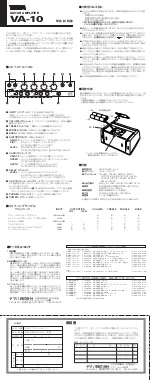
Balanced/Unbalanced Inputs
The CVA-7400/CVA-7800 incorporates XLR and Barrier Strip input
connectors, wired in parallel. This allows throughput of the signal to
additional amplifiers or other equipment such as DAT recorders, etc.
6-Gauge, 5-Way Binding Post and 1/4” Outputs
The CVA-7400/CVA-7800 Binding Posts output connectors will accept
banana plugs, spade lugs, or bare wire up to 6AWG. In addition, the
Binding Posts are positioned to allow one standard banana plug to be used
when operating the amplifier in bridged mode.
In-Rush Current Limiting
A breakthrough from Stewart, the CVA-7400 and CVA-7800 unique inrush
Current limiting circuitry minimizes power drawn from the wall to 8
AMPS or less on plug-in. Staggered turn-on configurations for
multiple-amplifier setups are now a thing of the past, as multiple amplifiers
may be switch on simultaneously.
Selectable High Pass Filter
A selectable high pass filter for each channel (32Hz, 68Hz, 150Hz at 12dB
per octave) has been incorporated for distributed systems.
High-Frequency Switch Mode Power Supply
The CVA-7400 and CVA-7800 features a radical departure from
conventional power supply design: Stewart’s High-Frequency Switch Mode
Power Supply . Because of this pioneering use of advanced technology,
some explanation is in order.
Conventional supplies operating at 60Hz (standard line frequency)
recharge only 120 times per second, requiring their storage capacitors and
transformer to be quite large to supply the energy needed during the
intervals between cycles when power is not available from the wall. The
power supply must act as a local reservoir of power from which the
amplifier circuits draw. This storage function is responsible for much of the
bulk, weight and cost of traditional power amplifiers.
The Stewart High-Frequency Switch Mode Power Supply fully recharges
120,000 times per second (1000 times faster than conventional supplies),
6
And out the top. In any case, be sure that the sides of the rack (next to the
amplifier) are clear of cables, power strips, etc., so that airflow is
maintained around the heatsink fins.
The amount of airflow is necessary will be determined by a number of
factors, including ambient temperature, the amount of heat generated by
other equipment in the rack, the properties of the rack enclosure being used,
and how hard the amplifier is working. Depending on the installation, it
may be necessary to guarantee airflow around the heatsinks by rearranging
system components or installing a cooling fan in the rack.
Note: T
o minimize thermal concern, an accessory cooling fan panel
may be installed. Fans may be installed in the front or rear of the rack
in the upper most slots. Fans should be blowing out of the rack. For
further information, please contact Stewart Audio’s customer service.
In a free-standing installation, in which the unit is sitting on a shelf or hard
floors, the rubber feet must be mounted to the bottom of the amplifier.
Under no circumstances should the amplifier be placed directly on carpeting
of a similar surface.
AC Power Considerations
Your Stewart amplifier is designed to operate on 120 volt, 60Hz alternating
current. Power consumption will depend on load impedance, signal level,
and dynamic properties of the program material. At 12.5? per channel,
power draw averages approximately 110 watts.
The CVA-7400/CVA-7800 is equipped with unique inrush current limiting
circuitry which minimizes power drawn from the wall to 8 Amps of less on
power up. Multiple amplifiers may all be switched on at once, without the
need for staggered turn-on configurations.
11




























